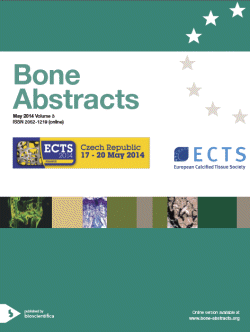
European Calcified Tissue Society Congress 2014
Prague,
Czech Republic
17 May 2014 - 20 May 2014

Poster Presentations
Cell biology: osteoclasts and bone resorption
ba0003pp152 | Cell biology: osteoclasts and bone resorption | ECTS2014
Involvement of LIGHT in multiple myeloma bone disease
Oranger Angela , Brunetti Giacomina , Mori Giorgio , Carbone Claudia , Gigante Isabella , Mongelli Teresa , Taurino Grazia , Rizzi Rita , Mestice Anna , Zallone Alberta , Specchia Giorgina , Colucci Silvia , Grano Maria
ba0003pp153 | Cell biology: osteoclasts and bone resorption | ECTS2014
Zoledronic acid differently affects long-bone and jaw bone remodeling
Vermeer Jenny A.F. , Renders Greetje A.P. , van Duin Marion A. , Jansen Ineke D.C. , Bakker Lieneke F. , Kroon Sophie A. , de Vries Teun J. , Everts Vincent
ba0003pp154 | Cell biology: osteoclasts and bone resorption | ECTS2014
Disruption of PLEKHM1 and TRAFD1 (FLN29) interaction impairs osteoclast resorptive activity
Witwicka Hanna , Jia Hong , Kutikov Artem , Hwang Sung-Yong , Odgren Paul
ba0003pp155 | Cell biology: osteoclasts and bone resorption | ECTS2014
Role of caveolin-1 in osteoclastogenesis
Kim Hong-Hee , Lee Yong Deok , Yoon Soo-Hyun
ba0003pp156 | Cell biology: osteoclasts and bone resorption | ECTS2014
Interleukin-34 and macrophage-colony stimulating factor interact to form a heteromeric and functional cytokine
Segaliny Aude , Brion Regis , Brulin Benedicte , Teletchea Stephane , Jardin Julien , Maillasson Mike , Charrier Celine , Heymann Dominique
ba0003pp157 | Cell biology: osteoclasts and bone resorption | ECTS2014
CCN2 induces osteoclastogenesis by regulating RANK/RANKL/OPG system
Aoyama Eriko , Kubota Satoshi , Nishida Takashi , Takigawa Masaharu
ba0003pp158 | Cell biology: osteoclasts and bone resorption | ECTS2014
Study of the molecular effects of disease-causing mutations in RANK using human protein expression models
Das Subhajit , Bramham Janice , Duthie Angela , Clark Susan , Crockett Julie
ba0003pp159 | Cell biology: osteoclasts and bone resorption | ECTS2014
Arachidonic acid and docosahexaenoic acid inhibits osteoclastogenesis and bone resorption in human CD14+ monocytes, in vitro
Kasonga Abe , Kruger Marlena , Coetzee Magdalena
ba0003pp160 | Cell biology: osteoclasts and bone resorption | ECTS2014
EEIG1 interacts with RANK receptor and positively regulates osteoclastogenesis
Jung Eutteum , Park Jin Hee , Choi Han Kyung , Lee Soo Young
ba0003pp161 | Cell biology: osteoclasts and bone resorption | ECTS2014
Ultrastructural imaging of the osteoclast secretory machinery in 3 dimensions
Helfrich Miep , Wilkinson Debbie , Mackenzie Kevin , Greenhorn John , Coxon Fraser
ba0003pp162 | Cell biology: osteoclasts and bone resorption | ECTS2014
The role of IL-6 as a modulator of osteoclastic resorption in vitro in acute Charcot osteoarthropathy
Petrova Nina , Petrov Peter , Edmonds Michael , Shanahan Catherine
ba0003pp163 | Cell biology: osteoclasts and bone resorption | ECTS2014
The molecular mechanism of n-butanol extracts of Panax notoginseng on RANKL-induced osteoclastogenesis in RAW264.7 cells
Hwang Hyo-In , Jang Young-Joo , Ko Seon-Yle
ba0003pp164 | Cell biology: osteoclasts and bone resorption | ECTS2014
Novel highly sensitive ELISA to measure free, bioactive, human soluble RANKL
Suciu Andreea , Breitwieser Andreas
ba0003pp165 | Cell biology: osteoclasts and bone resorption | ECTS2014
Foreign body giant cells do not have the capacity to resorb bone
ten Harkel Bas , Schoenmaker Ton , de Vries Teun J. , Everts Vincent
ba0003pp166 | Cell biology: osteoclasts and bone resorption | ECTS2014
Functional read out of perturbed osteoclast behaviour in an in vitro model of Gaucher's disease
Nijjar Sarbjit , Gittoes Neil , Geberhiwot Tarekegn
ba0003pp167 | Cell biology: osteoclasts and bone resorption | ECTS2014
Inhibitory effect of Crossostephium chinense extract on RANKL-activating osteoclastogenesis in patients with tophaceous gout
Wang Shih-Wei , Kuo Han-Chun , Hsu Hsia-Fen , Houng Jer-Yiing
ba0003pp168 | Cell biology: osteoclasts and bone resorption | ECTS2014
Effect of C-reactive protein on TRAP-positive multinucleated cell formation in RANKL-induced RAW264.7 cell culture
Choi Kyoung Hee , Hwang You Cheol , Jeong In-Kyung , Ahn Kyu Jeung , Chung Ho-Yeon
ba0003pp169 | Cell biology: osteoclasts and bone resorption | ECTS2014
Mechanosensitive TRP channels are required for Ca2+ signaling in osteoclastogenesis
Yang Yu-Mi , Lee Jiae , Shin Dong Min
ba0003pp170 | Cell biology: osteoclasts and bone resorption | ECTS2014
DBZ, a γ-secretase inhibitor, suppresses bone resorption by inhibiting c-Src activity
Jin Won Jong , Kim Ha-Neui , Kim Hong-Hee , Lee Zang Hee
ba0003pp171 | Cell biology: osteoclasts and bone resorption | ECTS2014
The purinergenic receptor P2Y14 is essential for RANKL-induced osteoclastogenesis
Park Jin Hee , Jung Eutteum , Lee Soo Young
ba0003pp172 | Cell biology: osteoclasts and bone resorption | ECTS2014
In vitro inhibitory activity on RANKL-mediated osteoclastogenesis of Glossogyne tenuifolia extract
Wang Shih-Wei , Kuo Han-Chun , Hsu Hsia-Fen , Tu Yuan-Kun , Cheng Tien-Tsai , Houng Jer-Yiing
ba0003pp173 | Cell biology: osteoclasts and bone resorption | ECTS2014
Inhibition of bone remodeling by bisphosphonate displaces the plasma cell niche into the spleen
Teufel Stefan , Grotsch Bettina , Luther Julia , Schinke Thorsten , Amling Michael , Schett Georg , Mielenz Dirk , David Jean-Pierre



